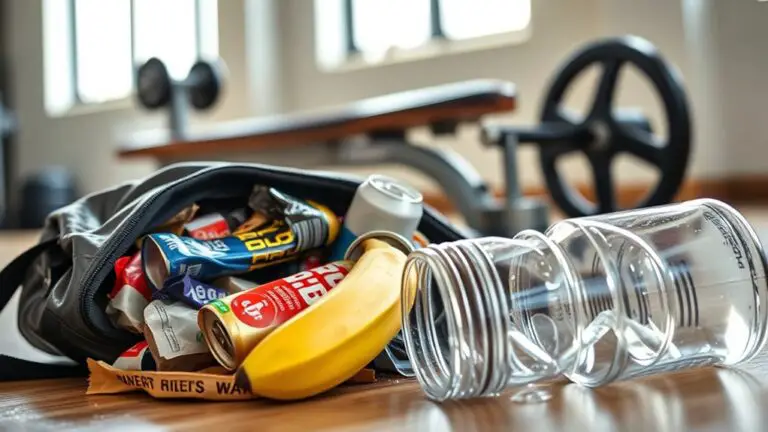Best Gym Recovery Techniques for Faster Healing

To recover faster after your workouts, focus on proper hydration and nutrition, as they’re essential for muscle repair. Incorporate dynamic stretching and foam rolling to improve blood flow and flexibility, while active recovery techniques like light cardio or yoga keep you mobile. Advanced methods such as massage and cryotherapy can further enhance recovery by reducing tension and inflammation. By prioritizing these techniques, you’ll optimize your healing process and discover even more effective strategies along the way.
Importance of Recovery in Fitness

When you push your body to its limits during workouts, recovery becomes essential to your overall fitness journey. It’s not just about feeling good; it’s critical for muscle repair and preventing injuries. Incorporating effective restoration strategies into your routine can make all the difference.
Restoration strategies involve techniques like gentle stretching, foam rolling, or even light yoga, which can help alleviate muscle tension and promote blood flow. Prioritizing sleep is also important, as it allows your body to repair itself naturally.
Hydration and Nutrition for Optimal Healing
To maximize your recovery, focusing on hydration and nutrition is essential. Proper hydration strategies help prevent fatigue and support muscle repair. Aim to drink water consistently throughout the day, especially before and after workouts. Additionally, pay attention to nutrient timing; consuming the right nutrients shortly after exercise can enhance recovery.
Here’s a table to guide you on hydration and nutrition:
| Time Frame | Focus Area |
|---|---|
| Pre-Workout | Hydrate and fuel with carbs |
| Post-Workout | Rehydrate and include protein |
| Throughout Day | Maintain hydration levels |
| Daily Nutrition | Balance carbs, proteins, and fats |
Stretching and Mobility Exercises

Incorporating stretching and mobility exercises into your routine can considerably enhance your recovery and overall performance. Focusing on dynamic stretching before your workouts helps improve blood flow and prepares your muscles for action, reducing the risk of injury. Gentle movements, like leg swings and arm circles, can help you get the most out of your sessions.
Post-workout, don’t skip foam rolling. This technique helps release muscle tightness and improve flexibility, allowing for faster recovery. By rolling over sore areas, you enhance blood circulation and break up knots in your muscles.
When integrating these techniques, listen to your body. Stretching should never feel painful; if it does, ease off. Consistent practice will not only promote healing but also improve your range of motion, making your workouts more effective. Prioritizing stretching and mobility guarantees you stay safe while pushing your limits in the gym. Additionally, strengthening pelvic floor muscles can further support recovery and prevent injuries during high-impact activities.
Active Recovery Techniques
Active recovery techniques are essential for promoting muscle recovery and enhancing overall fitness. These methods help you maintain mobility and prevent stiffness without overexerting yourself. Incorporating gentle activities can speed up your healing process and keep your body in peak condition.
Here are some effective active recovery techniques you can try:
- Dynamic stretching: Engage in gentle movements to improve flexibility and blood flow.
- Foam rolling: Use a foam roller to release muscle tension and improve circulation.
- Low-intensity cardio: Activities like walking or cycling can keep your heart rate up without straining your muscles.
- Yoga or Pilates: These practices enhance flexibility and promote relaxation, aiding recovery. Additionally, proper technique during low-impact activities like jump rope can further support your knee health.
Advanced Recovery Methods: Massage and Cryotherapy

While active recovery techniques provide a solid foundation for muscle healing, advanced recovery methods like massage and cryotherapy can take your recovery to the next level. Deep tissue massage is particularly effective for relieving muscle tension and improving circulation, helping your muscles recover more effectively. By targeting the deeper layers of muscle and connective tissue, you can alleviate soreness and enhance flexibility.
Foam rolling is another great option that complements these methods. It helps break up fascia and improve blood flow to your muscles, reducing recovery time considerably.
Cryotherapy, on the other hand, involves exposing your body to extremely cold temperatures, which can reduce inflammation and speed up recovery. It’s essential to approach cryotherapy with caution, ensuring you’re in a controlled environment with trained professionals.
Incorporating these advanced recovery techniques into your routine can help you heal faster and get back to your workouts safely.
Frequently Asked Questions
How Often Should I Incorporate Recovery Days Into My Routine?
You should aim to incorporate recovery days into your workout schedule at least once or twice a week. Recovery frequency is essential for preventing injuries and ensuring your body heals properly. Listen to your body; if you’re feeling fatigued or sore, it’s a sign you might need an extra rest day. Balancing workouts with recovery is key to maintaining your fitness safely and effectively, so don’t underestimate the importance of rest.
Can I Still Work Out While Recovering From an Injury?
Think of your body as a garden; sometimes it needs time to bloom after a storm. While you’re recovering from an injury, you can still work out, but it should be with modified workouts tailored for injury management. Listen to your body’s whispers; gentle movements can help maintain strength without overdoing it. Prioritize safety, and don’t rush the healing process—your garden will flourish again with the right care and patience.
What Are the Signs I Need More Recovery Time?
You should pay attention to your body’s signals when considering recovery time. If you’re experiencing persistent muscle soreness that doesn’t improve, or if your fatigue levels are higher than usual, it’s a sign you might need more rest. Ignoring these cues can lead to longer recovery or even further injury. Listen to your body; it knows best. Prioritizing adequate recovery will help you come back stronger and safer in the long run.
Is Sleep Really That Important for Muscle Recovery?
Absolutely, sleep’s essential for muscle recovery. When you sleep, your body releases growth hormones that aid in muscle repair and growth. You might not realize it, but quality sleep enhances your performance and reduces injury risk. The sleep benefits extend beyond just feeling rested; they directly impact your recovery time. So, prioritize getting enough restorative sleep to guarantee your muscles heal properly and you’re ready for your next workout.
Do Supplements Help With Recovery, and Which Ones Are Best?
Did you know that around 40% of athletes use supplements to enhance their recovery? While some can be beneficial, it’s crucial to choose wisely. Protein timing, for instance, can boost muscle repair if taken post-workout. Creatine benefits include improved recovery and reduced soreness, but make sure you stay hydrated. Always consult a healthcare professional before starting any supplement, ensuring it’s safe and suitable for your specific needs and goals.





